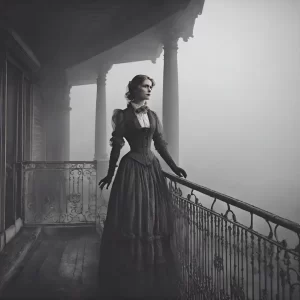Oak Alley Plantation

When you want a good ghost story, fewer settings are better than the wetlands of Louisiana and the state’s most historic cities. New Orleans is a breeding ground for energy, its boisterous personality shrouded in lingering darkness emboldened by devastating events like Hurricane Katrina and a history rife with slavery and oppression.
Located on the city’s outskirts, just west of Luling on the banks of the Mississippi River, sits a timeless structure whose walls have absorbed over 200 years of history. Today, Oak Alley Plantation, named for the oak trees that line the property, is a National Historic Landmark reserved for conveying its history and the surrounding 48 acres. Visitors are guided through multiple exhibits that cover distressing topics like slavery and the region’s race relations.
As they walk through the 11,500-square-foot Big House, they’ll feel the eyes of yesteryear gazing at them as residents and workers long since gone continue to stake their claim to the sprawling plantation.
Who is the Lady in Black at Oak Alley Plantation?
There are a few theories behind the identity of the Lady in Black. Keep reading to learn more about the most popular ones. For a firsthand look at New Orleans’ most haute locations, book a New Orleans ghost tour with NOLA Ghosts!
The Early Years of Oak Alley: Sugarcane & Slavery
The 21st century is all about reducing sugar consumption. Things were quite different over 200 years ago when civilization was ill-informed about the negative effects of the delectable treat. Securing sugar today is quite easy, but the same can’t be said for the 19th century. So, anyone who stood at the earliest stages of a viable sugar supply line could enjoy prosperity and affluence. With its wetlands and warmer environment, southern Louisiana was a potential gold mine sugarcane.
Enter Valcour Aime, an already well-to-do planter looking to expand his sugarcane operations. It’s with Aime that Oak Alley’s story begins. In the early 1800s, he purchased a plot of land along the Mississippi and laid the foundation (figuratively and literally) for what would become one of Louisiana’s most productive plantations. First, it would need a place for Aime to call home, and by 1839, the Big House, a Greek Revival-style mansion, was completed. However, by then, Aime had already sold the plantation off to Jacques Telesphore Roman, his brother-in-law.
The Romans weren’t the last family to call the Big House home, as Oak Alley Plantation was bought and sold on many occasions. Though new owners may have taken over the plot, one thing tended to remain the same — slaves worked the plantation fields.
Every individual that lived on the plantation imprinted a part of themselves onto it. Whether they lived through the heyday of sugarcane production or came about during times of disease, insects, and poor yields, the Big House and the nearby waters captured a piece of them, resulting in the return of their spirit after their passing.
Over time, the plantation experienced financial difficulties, ultimately forcing it to be sold at auction. With the Civil War over and new ideals sweeping the nation, the enslaved population found their freedom, and changes were desperately needed.
The plantation just needed someone to take the reigns, which Andrew and Josephine Sweet were happy to take on.
The New Owners and a New Purpose
The longer time went on, the more it seemed that Oak Alley would slowly decay as if a dark, malevolent force was rotting the plantation. The threat of time continued to weigh heavy on the land, its stained history of slavery and unspoken turmoils further rotting the once-lavished Big House.
Oak Alley could have been lost forever, and its important lessons have gone with it, but in 1925, Andrew and Josephine Stewart stepped in and purchased the land. One of their first tasks was to return the mansion to its former glory, which architect Richard Koch took on and completed. The plantation underwent a brief quiet period as the Stewarts enjoyed its fresh coat of paint and restored architecture.
Then, in 1972, the plantation changed hands once more. The Oak Alley Foundation took control of the acreage and Big House, using it as an educational tool. In the following decades, the foundation restored the slave worker dwellings, which were demolished during the Stewart renovation, and added exhibits dedicated to the archeological findings unearthed during excavations.
In 1976, the Oak Alley Plantation Restaurant & Inn opened its doors, welcoming curious locals and travelers with comforting southern cuisine and welcoming accommodations. Guests can sleep among the centuries-long history and, unbeknownst to many, walk amongst the plantation’s former workers and the mysterious Lady in Black.
Finding the Lady in Black
If you’re itching for a paranormal encounter, a Louisiana plantation is the perfect location to start. Oak Alley is especially primed for an eerie stay, its rows of oaks forming a natural canopy over the brick path leading to the Big House as an ominous welcome.
Guests who have stayed on the plantation grounds and visitors to the foundation’s exhibits tell of their ghostly encounters, some noting the presence of children and an unidentified old lady. Staffers warn of certain rooms within the Big House they prefer not to enter; otherwise, they find themselves in a restless antebellum spirit trapped within the beautiful structure.
Stories of flying candlesticks and an unidentifiable wailing specter are commonplace among staff. Still, one apparition most will agree has an undeniable hold on the plantation — the infamous Lady in Black.
Who the mysterious, long-haired shadow is remains a mystery. However, some believe it to be Celina Roman, the widow of Jacques Roman, who nearly bankrupted the plantation after her husband’s death. Has she returned to ensure no further damage comes to the estate? Or is the Lady in Black a wandering soul, a nameless victim of years of slavery just looking for release?
Want to hear more about the Lady in Black and explore the dark history of Oak Alley? Then visit our blog and check out our socials on Facebook, Instagram, and TikTok. Don’t miss out on an unforgettable evening! A ghost tour in New Orleans is your ticket through time, complete with a visit to the antiquated plantation.
Sources:
https://www.neworleans.com/listing/oak-alley-plantation/602/
https://www.gatorsandghosts.com/blog-archive//exploring-the-rich-history-of-oak-alley-plantation
https://www.loc.gov/item/la0544/
https://www.tclf.org/oak-alley-plantation
https://oakalleyplantation.com/about/
https://theshadowlands.net/famous/oakalley.htm
https://hauntedus.com/louisiana/oak-alley-plantation-haunted/
